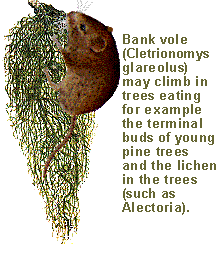To the main menu here!
THE WINTER OF OUR NORTHERN NATURE:
4. Hard midwinter/animal
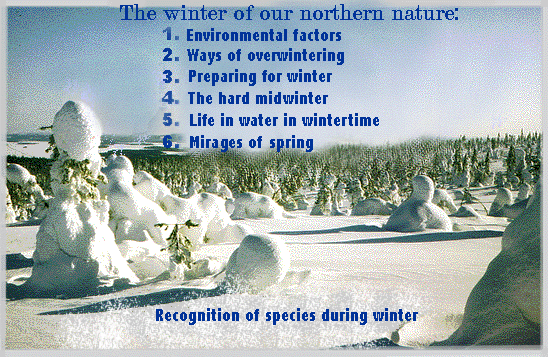

Hard midwinter:
The link to the hard winter of plants above.
Other topics on our northern nature are found from the picture above.
For other topics concerning nature, go to Main menu!
In this part: 'Hard midwinter/animals', part 2.
See also the wintering means of animals! and
preparing for winter!
...also:

Hard midwinter/animals:
•Lots of energy is consumed in a cold winter night
Small birds consume
most of the energy gained during the day already during the next night.
Most energy is consumed by those who roost on perches with no
protection against cold. However, a homeothermal animal can even fivefold its heat production when it gets really cold.The threat of active animals freezing to death
requires such low temperatures that we do not even reach here. (The same applies to most of our wild plants with
no protection of snow). More: The energy consumption of small birds!
The food eaten during the day turns almost immediately into fat stores,
a small bird has to use for heat production during a cold night. For
example, the weight of a great blue tit decreases by 7 to 10 % but
rises back during the day. Naturally, the loss of weight during the
night is also due to defecation. Roosting in a nesting box or a hollow
of a tree preserves quite a lot of energy during the night (about 10
%).
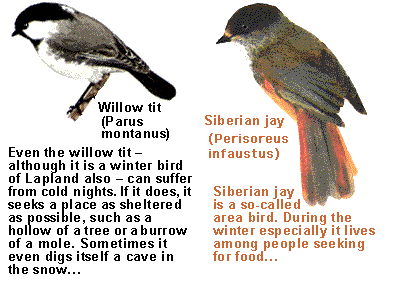
Fibrillation is an important thermoregulation mechanism with both birds and mammals. Also ruffling one’s feathers and putting one’s head into the feathers (under the wing) decreases heat loss and energy consumption. For
example, a Siberian jay “balled up” for the night uses only a bit more
than half of the use of energy of a Siberian jay in daytime posture.
Studies show that ruffling one’s feathers saves up to 10-30 % of the
energy of small birds.
At least with some small birdsthe body temperature lowers (= hypothermia) during extremely cold weather – and thus the energy consumption lessens.
Hypothermia is mainly a way to survive crisis,
crisis if there are no other ways to maintain the balance of body
temperature. The smaller the gab between air temperature and body
temperature, the slower the energy flow out of the bird is. For
example, both willow tit and siberian tit can lower their body
temperature up to even 8 to 9 degrees below normal (41 °C). This lowers
the energy consumption almost by a quarter. So far hypothermia has not
been found from even our smallest mammals.
• Our midwinter birdlife – only a part of it survives
We have about 40 to 50 species of winter birds who are regularly met and about a hundred who over-winter temporarily. As we have done winter bird counts, the winter birdlife of Finland is quite well-known.
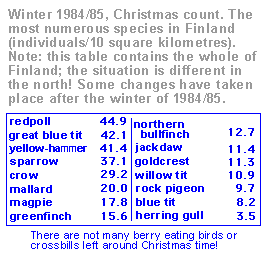
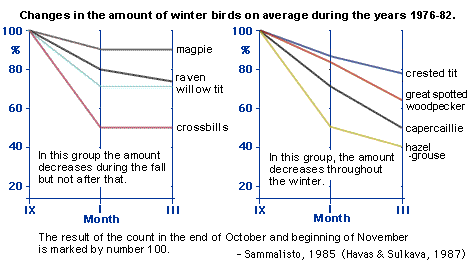
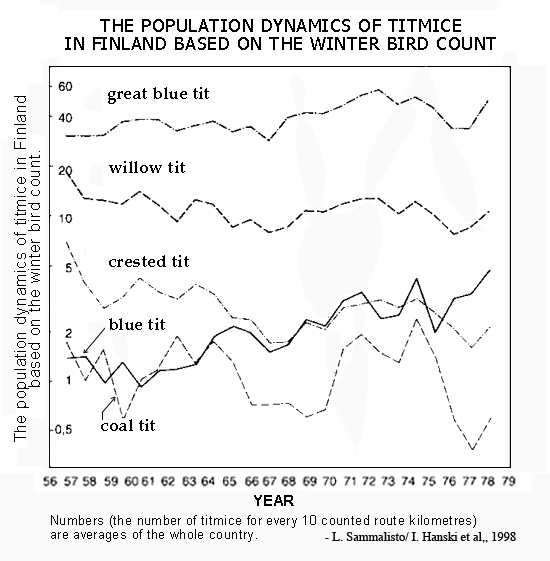
Picture
above: The winter count of titmice shows for example the differences in
population dynamics during winter between the different species.
The greatest variation has taken place in the winter population of coal
tit whereas the winter population of great blue tit and willow tit
have changed the least. The population dynamics of coal tit apparently
depend on the changes of the seed yield of spruces, at least to some
extent.
Great blue tit – in the north also the willow tit – is by
far the most numerous species of titmice. The number of blue tits has
increased
during recent years whereas the number of crested tits and willow tits has steadily decreased. Apparently the reason
for the decrease is the fall of old forests. See: population dynamics! In the wintery flocks of titmice, the different species
seek their way to different parts of a tree in order to be able to feed in piece.
During winter our birdlife decreases from before; birds die or they move elsewhere. Winter is a critical time especially to young animals (and plans also). For
example, about 40 % of the nestlings of ural owl die during their first
winter. Despite this, some species (for example moles) can even breed
during winter but only under the snow. Among some species – e.g.
goshawk – only the younglings move away from Finland for the winter.
During winter especially tiny birds die of cold, lack of food or get
eaten by beasts… The number of goldcrests falls even by 20 to 90 %
during winter, the number of magpies only by about 10 %.
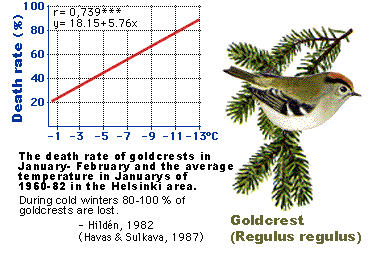
However, the number of certain species grows near habitation and feeding grounds.
• Small mammals live in the protection of snow during winter
Snow provides small mammals protection against subzero temperatures and beasts. .
In areas where there’s no or only little snow – e.g. in the south –
beasts eat most of the small mammals, which is why there is not much
gradation. But in areas where the amount of snow varies – in Lapland
for example – the gradation is usually high.
During midwinter animals climb on top of snow only rarely, usually to look for food. Bank vole particularly
can leave its tracks in the snow. It even climbs to trees where it
seeks for example for lichen and buds. The lichen Alectoria
especially is an important food plant for bank voles and they also
store it into the hollows of trees and bird nests for winter.
Shrew-mice
don’t really stand subzero temperatures of mid-winter: they stay under
the snow. However, during early and late winter their tracks can be
seen in the snow. They need a lot of food during winter but there isn’t
much of it. More: The life of a shrew-mouse is extremely dangerous especially in winter time!
Field vole especially makes so-called ventilation holes in the snow. The percentage of carbon dioxide
in the air can sometimes be very high under the snow so ventilation
might be needed. It has been discovered that small mammals flee places
with much carbon dioxide during winter. High percentage of
carbon dioxide slows down the heart rate of small mammals, decreases
the consumption of oxygen and lowers the temperature. Like this, the
animal tries to avoid stress caused by the high percentage of carbon
dioxide.
• The winter life of invertebrates…
Snow and soil provide protection to most invertebrates. Many of them spend the winter in dormancy.
Many of them are capable of preventing their cells from freezing. The
snow crystals which develop into the cell break its structure which is
often very dangerous. An animal can prevent this by for example
removing (extra) water from the cells and by increasing the amount of
glycerol (antifreeze) in the cell.
Species that tolerate exceptionally low temperatures are the permanent forms of some animals. For example some bear animalcules can cocoon into a rest stage with no water in them. They tolerate even -272°C.
The tolerance of invertebrates living on the ground
is probably not very good. During winter with little snow and very low
temperatures, for example, many worms and aster worms may die.
On the other hand, the insects and spiders as well as their pre-stages that spend their dormancy in the foliage of trees naturally tolerate quite mean temperatures. More: Insects' cold tolerance!
Under the snow many invertebrate animals are active even during the mid-winter. Under
the snow, where the temperature is close to 0 degrees Celsius, there
are for example ticks, springtails, spiders and beetle maggots (also
fully grown beetles).
In mild weather one can see some species of insects and spiders even on top of snow. As the spring progresses more and more species come up…
In late winter great amounts of small springtails (can
be seen in snow on mild weather. There are many different species of
them. They look for food from the snow, for example microscopic organic
material.
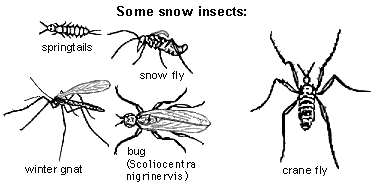
In
the midwinter, in low subzero temperatures, there are only few bugs and
snow gnats moving on top of snow. During snowdrift in spring (and early
winter) one can see snow flies as well as some beetles and small
butterflies in the nature. In addition, many species of spiders start
moving when the temperature is still a few degrees below zero.
Titmice
and goldcrests like eating the arthropods that spend their dormancy
time on top of snow (e.g. in the foliage of trees). Therefore, even 90
% of the spider population of trees may be destroyed during winter.








